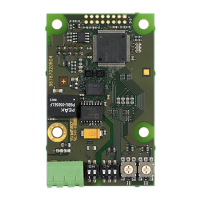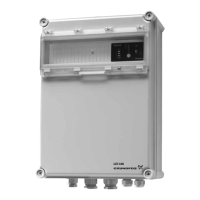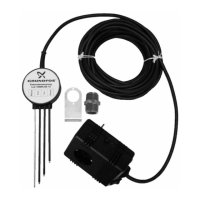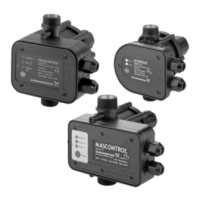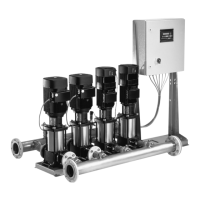English (GB)
2
English (GB) Functional profile and user manual
Original functional profile and user manual.
This functional profile describes Grundfos Modbus for boosters.
CONTENTS
Page
1. General information
1.1 Hazard statements
The symbols and hazard statements below may appear in
Grundfos installation and operating instructions, safety
instructions and service instructions.
The hazard statements are structured in the following way:
1. General information
2
1.1 Hazard statements
2
1.2 Notes
3
2. Introduction
3
2.1 About this functional profile
3
2.2 Assumptions
3
2.3 Definitions and abbreviations
3
3. System description
4
3.1 Modbus
4
3.2 CIM 200 Modbus RTU
4
3.3 CIM 260 3G/4G cellular Modbus
5
3.4 CIM 500 Modbus TCP
6
4. Specifications
7
4.1 CIM module
7
4.2 CIM 200 Modbus RTU
7
4.3 CIM 260 3G/4G cellular
8
4.4 CIM 500 Modbus TCP
8
5. CIM 200 Modbus RTU setup
9
5.1 Setting the Modbus transmission speed
9
5.2 Setting the stop bits and the parity bit
9
5.3 Modbus address selection
10
5.4 Termination resistor
10
5.5 Status LEDs
10
6. CIM 260 3G/4G cellular Modbus setup
11
6.1 Installation
11
6.2 LEDs
12
7. CIM 500 Modbus TCP setup
13
7.1 Connecting the Ethernet cable
13
7.2 Setting the Industrial Ethernet protocol
13
7.3 Setting the IP addresses
13
7.4 Establishing connection to the webserver
14
7.5 Status LEDs
14
7.6 DATA and LINK LEDs
14
8. Modbus function code overview
15
9. Modbus register addresses
16
9.1 Register block overview
16
9.2 CIM configuration register block
16
9.3 CIM status register block
17
9.4 Cellular network Real Time Clock
18
9.5 Control register block
18
9.6 Status register block
22
9.7 System data register block
25
9.8 Pump 1 register block
28
9.9 Pump 2 register block
28
9.10 Pump 3 register block
29
9.11 Pump 4 register block
29
9.12 Pump 5 register block
30
9.13 Pump 6 register block
30
9.14 Pilot pump register block, Hydro MPC only
31
9.15 Backup pump register block, Hydro MPC only
31
9.16 DDD Remote Sensor Data
32
9.17 Alarm simulation register block
34
10. Detailed descriptions of functionality
35
10.1 Control modes
35
10.2 Tank-filling applications
36
10.3 Setpoint in closed-loop control
36
10.4 Setpoint in open-loop control
36
10.5 Temperature calculation
37
10.6 Reading DDD remote sensor data
37
10.7 Alarms and warnings from the booster system
37
10.8 Alarms from the individual pumps
38
10.9 Sensor-based Modbus registers
39
11. Modbus RTU commissioning, step-by-step guides
41
11.1 Hardware setup, CIM 200
41
11.2 Hardware setup, CIU 200
41
11.3 Hardware setup, CIM 260 call-up connection
42
11.4 Hardware setup, CIU 260 call-up connection
42
11.5 Hardware setup, CIM 260 data connection
42
11.6 Hardware setup, CIU 260 data connection
42
11.7 CIM 500 Modbus TCP communication setup
43
11.8 CIU 500 Modbus TCP communication setup
43
12. Detailed descriptions of call-up and APN
44
12.1 Call-up
44
12.2 APN
44
13. Modbus RTU telegram examples
47
13.1 Modbus telegram overview
47
13.2 Read holding registers, 0x03
47
13.3 Read input registers, 0x04
47
13.4 Write single register, 0x06
47
13.5 Write multiple registers, 0x10
48
13.6 Diagnostics, 0x08
48
13.7 Diagnostics register interpretation
48
13.8 Diagnostics: Return query data
49
13.9 Reading the CIM configuration register block
49
13.10 Setting the setpoint
49
13.11 Setting the control mode
49
13.12 Starting the booster system
50
13.13 Stopping the booster system
50
14. Fault finding the product
51
14.1 CIM/CIU 200
51
14.2 CIM/CIU 260
53
14.3 CIM/CIU 500
55
15. Modbus RTU rotary switch addresses
57
Read this document before installing the product.
Installation and operation must comply with local
regulations and accepted codes of good practice.
DANGER
Indicates a hazardous situation which, if not avoided,
will result in death or serious personal injury.
WARNING
Indicates a hazardous situation which, if not avoided,
could result in death or serious personal injury.
CAUTION
Indicates a hazardous situation which, if not avoided,
could result in minor or moderate personal injury.
SIGNAL WORD
Description of hazard
Consequence of ignoring the warning.
- Action to avoid the hazard.

